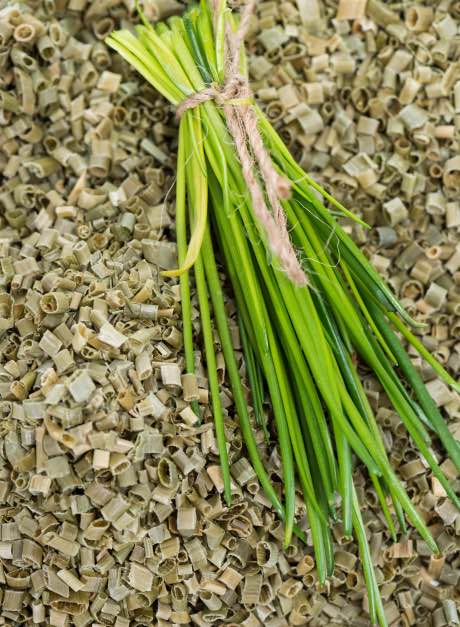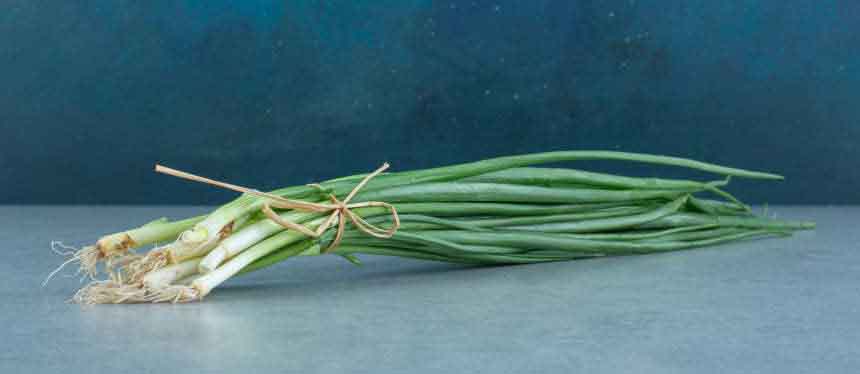There are so many reasons why we love chives. They are super easy plants to grow and work with a wide variety of dishes. For those looking for an easy way to add some greenery to their home, and flex their culinary muscle, chives are never a bad choice. I have used chives in everything from seafood dishes, to sauces, to pastas, and pretty much everything in between. Being able to grow and harvest my own chives has been a huge win, and helped me level up my cooking game.
Whether you grow chives indoors or outdoors, you want to make sure you’re harvesting them correctly. Don’t worry, the process is very straightforward, and we’ll walk you through each step.
When to Harvest
Knowing the right time to harvest chives is half the battle. Timing is important if you want to get the largest possible yield and the most flavor from the chives. Generally, chives are ready for harvest when they are at least six to eight inches tall, and should look a healthy, bright green.
We recommend harvesting chives in the morning, as this is the time when they are well-hydrated and possess the most intense flavor. If you harvest chives in the afternoon or evening, you might end up with drier, less flavorful herbs.
How Long Does It Take For Chives To Grow?
For those planting chive seeds, they’ll generally be ready for their first harvest about 60 days after planting. If you’re starting from a seedling, then it can be significantly shortened depending on how large it is. Keep this timeline in mind and you’ll be better available to determine when the proper time to harvest is. Keep in mind that this is for the first harvest, a single chive plant can be harvested multiple times over the course of a growing season.
How to Harvest Chives
Harvesting chives is actually a simple process, but it’s a matter of knowing the right methods so you can do it right the first time. By following our recommendations, you just might end up growing and harvesting better chives by the end of the season.
Check for Readiness
You’ll know chives are ready to harvest when they reach a minimum length of six to eight inches. For anything shorter, you might want to allow the chives to grow a bit longer before harvesting them. Leaves that are ready for harvest should be thick, green, and firm to the touch. Avoid harvesting leaves that are limp or discolored, as these are usually lower in flavor content.
Choose and Use the Right Tool
Some homeowners prefer garden shears while others prefer snippers or even kitchen scissors. The most important thing you should consider is that the tool you’re using has sharp, clean blades. Ensure they are sanitized to prevent the spread of any disease.
Cut the Chives
If you’re harvesting a few chives, then this part should be easy. However, if you’re harvesting a large batch, then we recommend tying the stems first before you cut them. Tying them up saves you the time it takes to bundle them up later after harvest. Plus, it makes everything easier for you.

In either case, start by grasping your chives firmly with one hand to keep them steady. Use the other hand to cut the chives. Make sure that you leave about an inch of growth above the soil. This will encourage new growth, which you can harvest again at a later date.
We recommend harvesting only a third of each clump of your chive plant. This allows your plant to regenerate and grow more leaves. Avoid pulling your chive plant out of the ground, unless you want to harvest the entire plant from leaf to bulb.
Harvest Often
Regular harvests will encourage your chives to produce new shoots and growth giving you more to harvest. Plus, regular harvests make your chives look tidier and cleaner. Cutting them often also helps prevent the plant from flowering which will ruin the flavor.
While some homeowners allow their chives to bloom, we prefer to avoid this. When chives start to flower, their flavor tends to change because the plant will be focusing its energy on the flowers instead of the leaves. Flowering chives tend to have tough, woody, and less flavorful leaves.
However, you can always harvest the flowers, which are completely edible. However, if your main goal is to grow chives for their flavorful leaves, then you want to harvest them frequently in order to avoid producing flowers.
Use or Store the Harvested Chives
Once you have your chives, you can decide if you’re going to use them fresh or dried. Fresh chives can be easily incorporated into a huge range of recipes and even used as garnishes. Fresh chives can be stored in the refrigerator in a plastic bag with a damp paper towel for up to a week. However, if you have more than you need, you can dry your chives for later use.
To dry them, simply hang the bundled stems in a warm, dry place away from direct sunlight. Drying can take anywhere from a week or two, so keep an eye on the bundled stems. Once they’re dry and brittle, remove them and store them in an airtight container. These can be used in place of fresh chives in the instance that you don’t have any on hand. I tend to find the flavor of dried chives a bit less intense, but it’s still better than letting them go to waste. I just plan to use a bit more in my recipes than when I have fresh ones.
Best Practices for Growing Chives
Harvesting flavorful chives is the reward for those growing this delicious plant. To help you make sure that you’re giving your chives the best care possible, we’ve compiled a quick list for you to go through.
Choose the Right Location
Chives thrive in full sun and in well-draining soil. While they can tolerate partial shade, we recommend growing them in an area that gets at least six hours of sunlight per day and in loose soil with good drainage.
Water Regularly
The secret to tender, flavorful chives is the amount of water they get from the soil. However, you should also avoid overwatering them since they are susceptible to root rot. Simply keep the soil evenly moist, but not overly wet, and you’re good to go. I check the soil every day, and water once the top 2-3 inches is dry.
Fertilize Sparingly
Chives don’t really need a lot of fertilizer, but you can give them a boost once or twice during the growing season. We prefer compost as it’s organic and releases nutrients slowly over time while improving overall soil quality. Avoid over-fertilizing, though, as it can cause excessive growth of leaves but at the expense of flavor.
Mulch to Retain Moisture
Add an inch or two of mulch around the base of the chives and avoid covering the crown. We recommend using organic mulch made from shredded leaves, straw, or grass clippings. Mulch also helps suppress weed growth and regulate soil temperature.
Divide Chives Every Few Years
Chives can clump and crowd over time, so it’s a good idea to divide them every few years to encourage healthy growth. To do this, simply dig up the clump and separate it into smaller clumps before replanting them in well-draining soil. This is also a great way to grow your garden without needing to buy extra plants!
Final Thoughts on Harvesting Chives
It only takes the right amount of knowledge to grow and harvest healthy chives. Whether you’re doing it as a gardening passion, in pursuit of culinary excellence, or both, cultivating and enjoying the wonderful flavors of chives is a simple process.







